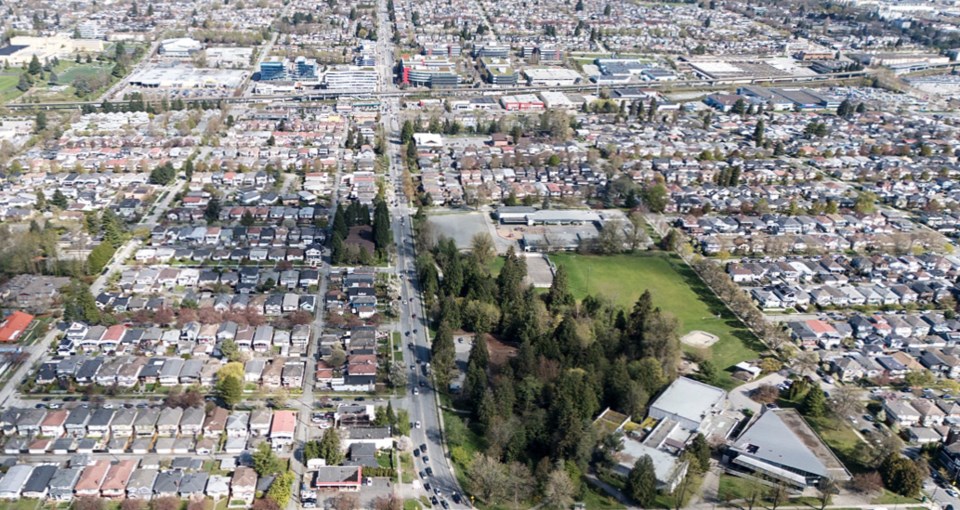The Rupert and Renfrew Station Area Plan.
What the heck is it?
It’s essentially what its name says—a plan for the 660-hectare area in and around the Rupert and Renfrew SkyTrain stations in East Vancouver.
The boundaries are roughly Kamloops Street east to Boundary Road, and Parker Street south to East 27th Avenue. The plan area includes the Renfrew Ravine and Still Creek, one of the last remaining salmon-bearing streams in the city.
On July 8, city council unanimously approved the 422-page plan, which will guide growth and change over the next 30 years for what is already a diverse area of housing, big box stores, industry, transit and rail traffic.
'Take several years'
Council’s approval, however, didn’t come without concerns around the infrastructure and public amenities such as community centres needed to accommodate the growth, with 10,000 homes and 8,000 jobs anticipated to be created over the next 25 years.
The water system in the southern portion of the area, for example, cannot currently provide the flows necessary to fight fires under the proposed heights and densities in the plan.
“This area requires the City to design and construct new infrastructure to upgrade the system, which is expected to take several years,” the plan said.
“As a result, the plan does not support new rezoning applications for buildings beyond what is allowed under existing zoning in this area until the upgrades are completed.”
The plan pointed out that the market’s shift to rental housing, combined with rising construction costs in the residential sector, will result in proportionately less development contributions towards infrastructure and amenities.
“Capital projects in the Rupert and Renfrew Area will be integrated into the City’s capital planning and budgeting processes for prioritization and any funding gap will need to be addressed through trade-offs on a city-wide basis,” the plan said.
“Based on the best available information, a limited portion of the plan could be implemented within the City’s projected funding capacity.”
'Human habitation'
The city staff report’s reference to “trade-offs” was mentioned by Coun. Pete Fry in his closing remarks to council last week. Fry said the “heavy lifting” for infrastructure upgrades should not fall on the City alone.
“These infrastructure conversations are going to be significant and ongoing, and it is something that we need to really wrap our head around as we add these significant pieces of density,” he said, noting the plan’s commitment to floodplain mitigation, wetland restoration and the preservation of employment lands designated for business activity.
Rail traffic was another concern raised by Fry, noting his experience as a Strathcona resident, where trains carrying freight run through the neighbourhood. Building more housing in the Rupert-Renfrew area near train tracks needs to be properly considered, he said.
“I know that we're adhering to the rail proximity guidelines around livability and setbacks,” Fry said.
“But there's bigger conversations here when it comes to how we expand into formerly industrial lands and reconcile livability and human habitation with heavy industrial use like freight rails and transport rails running through their future neighbourhood."
'High level of uncertainty'
The plan said the City will continue to pursue advocacy through the Federation of Canadian Municipalities on modernization of the "municipal growth framework to address funding challenges associated with renewing and expanding infrastructure and amenities."
At the same time, the plan warns: “The current funding environment has a high level of uncertainty, with constraints on funding based on the current and future economic and development environment, provincial legislation changes impacting developer contributions, inflation and limited availability of property tax funding.”
Implementation of the Rupert-Renfrew plan will be carried out through a mix of site-by-site rezonings, City-initiated rezonings and development permits under existing zoning. Rapid transit areas near the SkyTrain stations will see high-density towers up to 45 storeys.
Some facts about the residents who currently live in the area:
• Of approximately 31,000 people, more than 70 per cent identify as members of a visible minority (2021 Census). This proportion is significantly higher than the city average of approximately 55 per cent.
• The top four languages spoken at home within the area, other than English, are Cantonese, Vietnamese, Mandarin and Tagalog.
X/@Howellings





